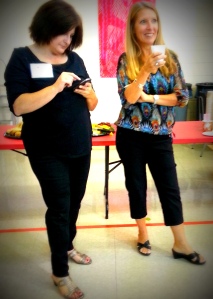Recently my 5th graders completed the following project. It challenged their thinking and they produced some noteworthy writing in the process. I would love to get your feedback on how to develop this approach so I welcome your comments and suggestions.
Thank you!
Kathy Shields
How to Become a Conversation-Starter
Science Magazine Article: The Research Process & Product Duration: 3 weeks
Writing is a conversation. It is an opportunity to hear yourself think and to let others follow along. The purpose of this project is to produce a unique magazine article on a science topic, by asking open-ended questions, leading to the collection of information from 3 unique sources and then blending the information in a new way that makes people curious. In preparation for this project, you examined several articles written for science publications. The Polar Bear article wasn’t just a list of facts about the animal; it asked the question, “Can polar bears be saved from extinction?”
Your goal is to ask a question that stimulates conversation
Reviewing the polar bear article, you discovered after much ‘close’ reading, that some of the facts cited supported the author’s claims, while others did not. You analyzed the writing and discussed the ways in which the author actually made you wonder even more about the original question after reading the article. This is your goal! Share your thinking and get others to keep thinking about what you’ve shared.
Potential Sources:
- Hard copy books from experts found in the Media Center like, “Dolphins” by Dr. Diana Diver, trainer for Sea World.
- Online Encyclopedias such as Galileo or Groliers (not Wikipedia)
- Magazine articles, either online or from the Media Center from a well-known science publisher such as National Geographic or Scholastic.
Your goal is to teach your reader how to look at a topic in a new way
Your research introduces your reader to your unique point-of-view. It is NOT a list of facts. It takes the reader on a thinking-journey. The reader may never have wondered about this topic until you mentioned it. For example, you may ask, “Do animals in zoos suffer from allergies the way people do?” Your goal is to teach your reader how to look at a topic in a new way and to get them interested enough to ask their own questions.
Developing a research strategy takes careful planning
How do you find the answers to your own questions? There may be a book on your subject; however, the chances are that you will discover articles written on this subject by experts. How will you take notes and turn this information into an interesting article?
Planning and Preparing to Write:
- Select a topic/subject to investigate. This is NOT the animal research topic from grade 3. If all of your research can be found in one book/source, you do not have a topic. Your topic MUST combine findings from 3 independent sources to make comparisons or to spur more interest in the subject. For instance: We learned that zoos are working to preserve the polar bear population. How are they doing this? Are they being successful? Can they really prevent polar bear extinction? The only way to answer this question is to look for different examples and to compare them. Instead of drawing conclusions, you may end your article by asking even better questions.
- Brainstorm questions you have about the topic. These are open-ended questions that can’t be answered using a list of facts.
- Choose three open-ended questions to guide and structure your research.
- Plan your Google searches. Get creative.
- The topic may be, The Northern Lights and the search results provide you with information from NASA and the WeatherChannel. This is a start.
- How can you find out something more? Think differently. Google, northern lights in ancient times. This approach will expand your understanding and may provide an interesting angle for your story.
- Cite your sources. Using the resource forms, fill in as much detail as you can such as the article title, the author, the date written and of course, the URL. This will make it easier to return to the article for you and your future readers. In your final draft, use the MLA citation guide to put the information into the standard form.
- You may use your wiki page to collect the citation information by copy/pasting the URL and describing the information you found on that site. This works well using a table. Those of you who do online research with a wiki will always have access to your information unlike those who save it on cards or on the school server.
- Take notes by paraphrasing the information. Always record the source so that you can link your findings to the author within your own article. Your writing will have more authority if you cite your sources. Readers will trust your facts if they know you found them in a credible source.
- Wikipedia is not a reliable source for 1st hand information, but it is an excellent starting point to find credible sources. Scroll to the bottom of the Wikipedia article on your topic to review the list of sources. You may not have access to all of the books listed, but you can click through to some of the articles and websites you see. You can also Google articles by using the expert’s names.
- Now that you have developed a better understanding for your topic, having three different resources, you can begin to draft your article. Give an ‘elevator pitch’ to several peers to see if they find your topic worth reading. You must stress your unique point-of-view. If they have questions, ask yourself if the article will answer their questions. If the answer is yes, you have found an audience! You may also ask them to provide a wish and a start to guide your revisions.
10. The final copy: Write each paragraph as if you were answering one question at a time and using 1 cited resource as evidence to support your claims. Conclude the article by tying the three paragraphs together. Your article may not answer the questions fully because you are an investigator not an expert. It may get your reader interested enough to continue their own investigation. That’s your goal!
Publishing your work
Your final product MUST include your citations and may also include 2-3 images that draw attention to your topic and appeal to your audience.












